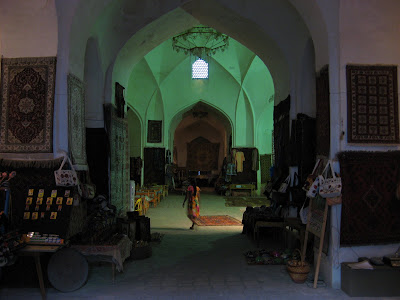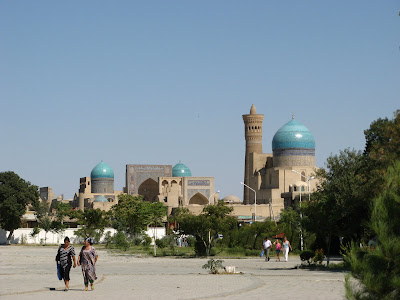
The roadside cafe served a variety of dishes including some with vegetables in! Most places just serve plain greasy minced mutton kebab, plov, which is just a few bits of boiled mutton on a pile of greasy rice, or manty, which is a kind of greasy boiled mince and onion dumpling. We were all getting a bit fed up with eating nothing but plain greasy meat. Trouble was I had no idea what this other stuff was that was being served up or how to ask for it. It was all coming through a small hatch so I couldn't even point at what I wanted. Got some aubergine thing in the end though.
The toilets were minging, as you'd expect. We had now travelled further east than the concept of the cubicle. People don't seem to be a very good aim in this part of the world and they don't believe in ever cleaning a toilet for some reason. So what you've got is basically two large open concrete shelters full of crap and flies. Worse for women cos at least a bloke is used to using open urinals and doesnt have to squat every time.
As we approached Bukhara in dusk the landscape became farmland with a linear development of scruffy houses along the side of the road.
The bus dropped us on the outskirts of Bukhara. Taxi drivers swarmed around like flies shouting and fighting over our potential custom. I just took it really slow and pretty much ignored them while I found out the name of the place we were going to head for. The prices the taxi drivers were offering were very high. We tried negotiating. One driver told us it was 15 km into the town. I was a bit surprised and even for 15 km the price was too high. But we couldn't get them to offer any lower. Reluctantly we took a ride. It was about 3 km. We argued with him when we got there and tried to give him half the money but he wasn't having any of it. Taxi drivers in Uzbekistan are the worst!
Straight away we got hassled by a young teenager trying to get us to stay at a hotel. We had been given details of a good value guesthouse by the girl at the guesthouse in Khiva so we went to that. They were full but the kind brother there took us to a friends place where we got a good value room.
The next day we headed out to look around Bukhara.

Bukhara is the birthplace of Nasruddin Hoja. He lived in Anatolia (Turkey) in the 13th century and was a popular Sufi wise man. He is famous in Islam today because there are many short stories, about him. They are parables and light-hearted anecdotes used to convey simple spiritual teachings.
This big building with majestic bird murals on the front is the Nadir Divanbegi Medressa. It was originally a caravanserai but became a medressa in 1622. Inside is a big courtyard where people are selling handicrafts and tea.



This is the Ulugbeg Medressa. It is being 'restored'. Actually, I'd call it destruction. They are ripping off all the hundreds-of-years-old mosaics and replacing them with poorly made cheap panels. Its distressing.
Opposite is the Abdul Aziz Khan Medressa, also being completely and utterly destroyed in the name of 'restoration'.
The square in front of theMir-i-Arab Medressa. On the right is the 16th century Kalon Mosque and the Kalon Minaret. The minaret was built in 1127 for an earlier mosque which was destroyed by Genghis Khan. It was probably the tallest building in Central Asia when it was built.
As you walk out of the mosque you climb some steps up to the door. As you approach the doorway it opens up the view of the beautiful facade of the Medressa across the courtyard. The way the space of the courtyard and the height of the great iwan opens up as you walk through the door is something really special. The height of the iwan draws the eyes and the mind upwards toward the heavens. Approaching the space of the courtyard through such a high iwan gives an incredible uplifting feeling and at the same time a feeling of being so small in comparison the wonder and beauty of Allah, in whose name these religious buildings were built. It's an awe-inspiring place that photos can't do justice to.
Sitorai Mohi Hosa; Emir's Summer Palace or 'Star and Moon Garden'. A 17th century summer residence and harem of Alim Khan, the last emir.
The pool where the women of the harem would frolick. The emir would toss an apple to his chosen bedmate.
Inside the palace. Crazy colour scheme and intense kind of psychadelic decor. The emir was way ahead of his time! This is from the 1700's. It looks kind of 1970's funky style or like something from Yellow Submarine.
The entrance to the Ark. The Ark is where all the important stuff was, the treasury, the governors etc.
A covered bazaar.









































No comments:
Post a Comment